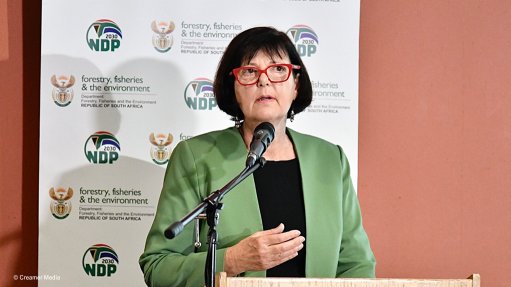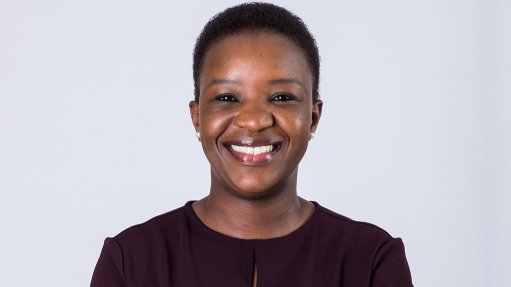S&P places Eskom on CreditWatch positive on expected government support
Ratings agency S&P Global Ratings has placed its ratings on State-owned utility Eskom on CreditWatch with positive implications, including its ‘CCC+’ issuer credit rating and 'zaB' South Africa national scale long-term rating.
S&P attributes this to the South African government’s planned R254-billion ($14-billion) debt relief agreement, which the agency expects will address Eskom’s near-term debt obligations once implemented and give the utility room to focus on operational improvements and electricity sector reform targets.
Moreover, it expects the agreement to improve Eskom’s liquidity and capital structure and put the company on a path to financial sustainability, notwithstanding severe operating challenges that remain.
The CreditWatch placement reflects that S&P could raise the rating by one or more notches based on its expectations that the debt relief agreement, when implemented, will strengthen Eskom’s liquidity over time.
The government’s proposed debt relief agreement will reduce refinancing risks and improve Eskom's near-term liquidity profile, S&P avers.
It says the agreement will address Eskom’s debt maturity and interest obligations (totalling R184-billion) over the fiscal year 2024 (ending March 31, 2024) to fiscal year 2026 through subordinated loans provided by the government and see the transfer of up to R70-billion of loans to the government in fiscal 2026.
The agreement will ensure that Eskom can meet its debt obligations as they fall due over the next three years, reducing the likelihood of a default owing to a liquidity crisis, it adds.
S&P expects the entity’s sources of liquidity will cover uses by about 1.1x–1.2x on average over the period, whereas its current base case points to sources covering uses by under 0.7x.
The agreement could also see a reduction in gross debt for Eskom and a reduction of leverage to more sustainable levels by fiscal 2026, from S&P Global Ratings-adjusted debt to earnings before interest, taxes, depreciation and amortisation (Ebitda) of 11.9x in fiscal 2021 and 7.4x in fiscal 2022.
S&P expects the debt relief agreement will be broken down as R78-billion of subordinated loans from the government in fiscal 2024; R66-billion of subordinated loans from the government in fiscal 2025; and R40-billion of subordinated loans from the government and a transfer of up to R70-billion of Eskom's loan portfolio by the government in fiscal 2026.
S&P expects the subordinated loans will match the debt and interest obligations Eskom owes each fiscal year and be disbursed on a quarterly basis in line with each quarter’s contractual payments.
It also thinks that Eskom’s finances will remain sensitive to further deterioration in electricity generation volumes and management of its capital expenditure (capex) cycle.
Under the debt relief agreement, Eskom will be prohibited from raising additional debt through the period and will need to generate sufficient revenue to cover operating and repair costs and capex obligations.
The recent award of an 18.5% tariff increase for fiscal 2024 and 12.5% for fiscal 2025 by the National Energy Regulator of South Africa (Nersa) will also improve revenue visibility and be more cost-reflective, S&P asserts.
However, deteriorating electricity volume production, coupled with weak economic growth conditions in South Africa, will mean that Eskom will, in the rating agency’s opinion, not meet regulated allowable revenue levels in either year.
With load curtailment expected to last for at least the next 24 months, S&P thinks lower electricity volumes supplied, high use of expensive diesel-powered open cycle gas turbines (OCGTs) and large working capital outflows owing to nonpayment by municipalities will remain key risks to cash flows.
It thinks capex could increase in the coming years to about R50-billion, from R31-billion in fiscal 2022, with more spending directed to the transmission network. However, it believes Eskom has flexibility and will use its discretion to base capex spending on operating cash flows.
Gross debt reduction will also hinge on Eskom achieving conditions set by the National Treasury, S&P states.
“We understand that Eskom will receive the loans, which will be interest-free initially, from the government in quarterly tranches. Eskom will use these to settle upcoming maturities and interest payments.
“The National Treasury will tie conditions to the loans that are aimed at operational improvements and reducing leverage. We understand that Eskom's progress in achieving the conditions will be measured on a quarterly basis; if conditions are achieved, the loans will be replaced with equity issuances, and if the conditions are not achieved, the loans will attract interest at market rates,” S&P says.
It expects to treat the subordinated loans as debt in its assessment of Eskom’s financial profile because the loans can attract interest. S&P forecasts gross debt could reduce to about R255-billion by the end of fiscal 2026 from about R420-billion currently, if Eskom is successful in replacing all subordinated loans with equity.
The gross debt reduction will help Eskom to reduce leverage, but Eskom’s long-term financial sustainability will depend on its ability to increase Ebitda margins and generate positive free operating cash flows before the debt relief agreement ends, S&P posits.
S&P points out that Eskom’s liquidity is still weak and could be at risk if there is a delay in the implementation of the agreement.
It currently expects that the government’s Eskom Debt Relief Bill of 2023 will be signed and that the agreement will be implemented by mid-2023.
“We understand that Eskom will need to raise funding externally, or use existing cash balances to settle interest and debt obligations until the agreement is implemented. Given Eskom’s existing weak liquidity and sizeable debt maturities in fiscal 2024 that total about R46-billion, we believe that a delay in the implementation beyond mid-2023 will pressure liquidity and may require emergency support from the national treasury as an interim measure,” S&P says.
The CreditWatch positive placement reflects that the agency could raise the rating by one or more notches based on its expectation that Eskom’s liquidity position will strengthen and that the risks of a near-term default event will reduce once the debt relief agreement is implemented.
S&P expects to resolve the CreditWatch in the coming quarters once the Eskom Debt Relief Bill has been signed and the agency obtains documentation on the terms and conditions of the agreement between treasury and Eskom.
For an upgrade, it would also need to observe a track record of subordinated loans from the government being replaced with equity issued by Eskom.
The ratings would come under downward pressure if there is a delay in the implementation of the debt relief agreement beyond mid-2023, with no interim measures to address Eskom’s near-term debt maturities and liquidity until the agreement is implemented, or if there is further unforeseen deterioration in Eskom's operating performance, S&P indicates.
Comments
Announcements
What's On
Subscribe to improve your user experience...
Option 1 (equivalent of R125 a month):
Receive a weekly copy of Creamer Media's Engineering News & Mining Weekly magazine
(print copy for those in South Africa and e-magazine for those outside of South Africa)
Receive daily email newsletters
Access to full search results
Access archive of magazine back copies
Access to Projects in Progress
Access to ONE Research Report of your choice in PDF format
Option 2 (equivalent of R375 a month):
All benefits from Option 1
PLUS
Access to Creamer Media's Research Channel Africa for ALL Research Reports, in PDF format, on various industrial and mining sectors
including Electricity; Water; Energy Transition; Hydrogen; Roads, Rail and Ports; Coal; Gold; Platinum; Battery Metals; etc.
Already a subscriber?
Forgotten your password?
Receive weekly copy of Creamer Media's Engineering News & Mining Weekly magazine (print copy for those in South Africa and e-magazine for those outside of South Africa)
➕
Recieve daily email newsletters
➕
Access to full search results
➕
Access archive of magazine back copies
➕
Access to Projects in Progress
➕
Access to ONE Research Report of your choice in PDF format
RESEARCH CHANNEL AFRICA
R4500 (equivalent of R375 a month)
SUBSCRIBEAll benefits from Option 1
➕
Access to Creamer Media's Research Channel Africa for ALL Research Reports on various industrial and mining sectors, in PDF format, including on:
Electricity
➕
Water
➕
Energy Transition
➕
Hydrogen
➕
Roads, Rail and Ports
➕
Coal
➕
Gold
➕
Platinum
➕
Battery Metals
➕
etc.
Receive all benefits from Option 1 or Option 2 delivered to numerous people at your company
➕
Multiple User names and Passwords for simultaneous log-ins
➕
Intranet integration access to all in your organisation


















